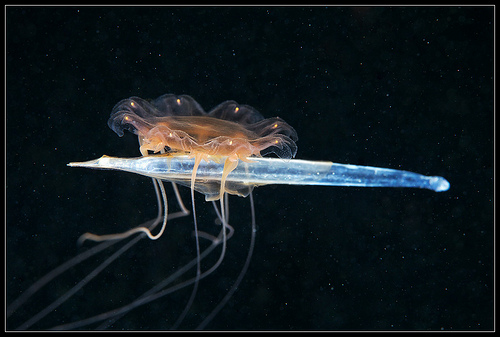Nutrition
Feeding
 The Lion's mane jellyfish is a voracious predator
and is so successful due to its large tentacles reaching upwards of
200 feet. There are 8 groups, all of which contain
approximately 150 tentacles! Lining these tentacles are
stinging cells called cnidocytes. To learn more about these
cnidocytes the Lion's Mane uses to capture its prey, visit
my Modifications page! Cyanea capillata use
not only its enormous number of tentacles to capture prey, but also
its extended oral arms that are about the length of the
bell. Once it has captured its meal, it uses the oral
arms to bring its prey to its mouth. You can see this
process in action in the picture to the right of this text.
This picture was obtained through Alexander Semenov.
The mouth then starts to break down the organism and distribute
nutrients through the radial canals. These radial
canals provide the tentacles with enough nutrients to move
the organism and hunt its prey. You can see a more
detailed image of a Lion's Mane's morphology also on my
adaptations page. If you want to check out an even
more voracious organism, look at
Phoneutria fera (Brazilian wandering spider)!
The Lion's mane jellyfish is a voracious predator
and is so successful due to its large tentacles reaching upwards of
200 feet. There are 8 groups, all of which contain
approximately 150 tentacles! Lining these tentacles are
stinging cells called cnidocytes. To learn more about these
cnidocytes the Lion's Mane uses to capture its prey, visit
my Modifications page! Cyanea capillata use
not only its enormous number of tentacles to capture prey, but also
its extended oral arms that are about the length of the
bell. Once it has captured its meal, it uses the oral
arms to bring its prey to its mouth. You can see this
process in action in the picture to the right of this text.
This picture was obtained through Alexander Semenov.
The mouth then starts to break down the organism and distribute
nutrients through the radial canals. These radial
canals provide the tentacles with enough nutrients to move
the organism and hunt its prey. You can see a more
detailed image of a Lion's Mane's morphology also on my
adaptations page. If you want to check out an even
more voracious organism, look at
Phoneutria fera (Brazilian wandering spider)!
Prey
 Cyanea capillata
is an outstanding predator that many organisms under
the sea fear. One of the Lion's Mane's favorite meals
is the moon jelly (Aurelia aurita)
which you can find in the
Classification page! Another very important organism
the Lion's mane consumes is the Comb jelly. Comb
jellies have been gaining attention because they have been
decimating the zooplankton in the local communities. This
had horrific side affects to the ecosystem as a whole.
Do not worry, Cyanea capillata is here! The
Lion's Mane is a natural predator of the Comb jelly.
There is a large debate on whether or not to introduce more
Lion's Mane to the areas being overrun with Comb jellies.
You can find an image of a Lion's Mane eating a comb jelly
in my Facts page!
Yet another interesting meal of the Lion's Mane is
Sagitta minima.
These arrow
Cyanea capillata
is an outstanding predator that many organisms under
the sea fear. One of the Lion's Mane's favorite meals
is the moon jelly (Aurelia aurita)
which you can find in the
Classification page! Another very important organism
the Lion's mane consumes is the Comb jelly. Comb
jellies have been gaining attention because they have been
decimating the zooplankton in the local communities. This
had horrific side affects to the ecosystem as a whole.
Do not worry, Cyanea capillata is here! The
Lion's Mane is a natural predator of the Comb jelly.
There is a large debate on whether or not to introduce more
Lion's Mane to the areas being overrun with Comb jellies.
You can find an image of a Lion's Mane eating a comb jelly
in my Facts page!
Yet another interesting meal of the Lion's Mane is
Sagitta minima.
These arrow worms are skilled
predators in its own way but are no match for the Lions
mane. You can see an image of Cyanea capillata
consuming an arrow worm to the left of this text. This
photo was obtained through Alexander Semenov. Since
Cyanea capillata is a well known hunter it should not
surprise you that its list of entrees is not finished.
The next victim of the Lion's
Mane is Sarsia tubulosa. This tiny jellyfish
is a good snack for the giant Lion's Mane. You can
see an image of this meal in action to the right of this
text. This photo was also taken by Alexander Semenov.
Cyanea capillata also eats other Lion's Manes,
krill, and some small fish.
worms are skilled
predators in its own way but are no match for the Lions
mane. You can see an image of Cyanea capillata
consuming an arrow worm to the left of this text. This
photo was obtained through Alexander Semenov. Since
Cyanea capillata is a well known hunter it should not
surprise you that its list of entrees is not finished.
The next victim of the Lion's
Mane is Sarsia tubulosa. This tiny jellyfish
is a good snack for the giant Lion's Mane. You can
see an image of this meal in action to the right of this
text. This photo was also taken by Alexander Semenov.
Cyanea capillata also eats other Lion's Manes,
krill, and some small fish.
Are you lost? Go back to my Home Page!